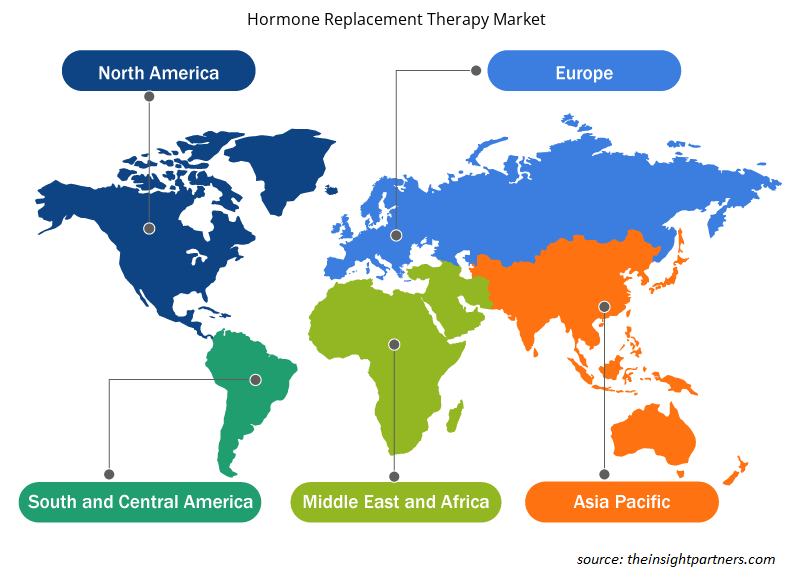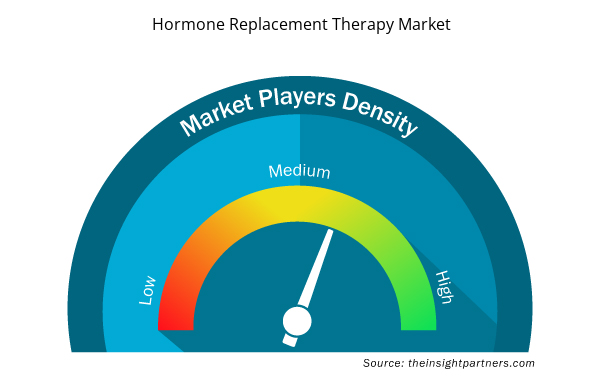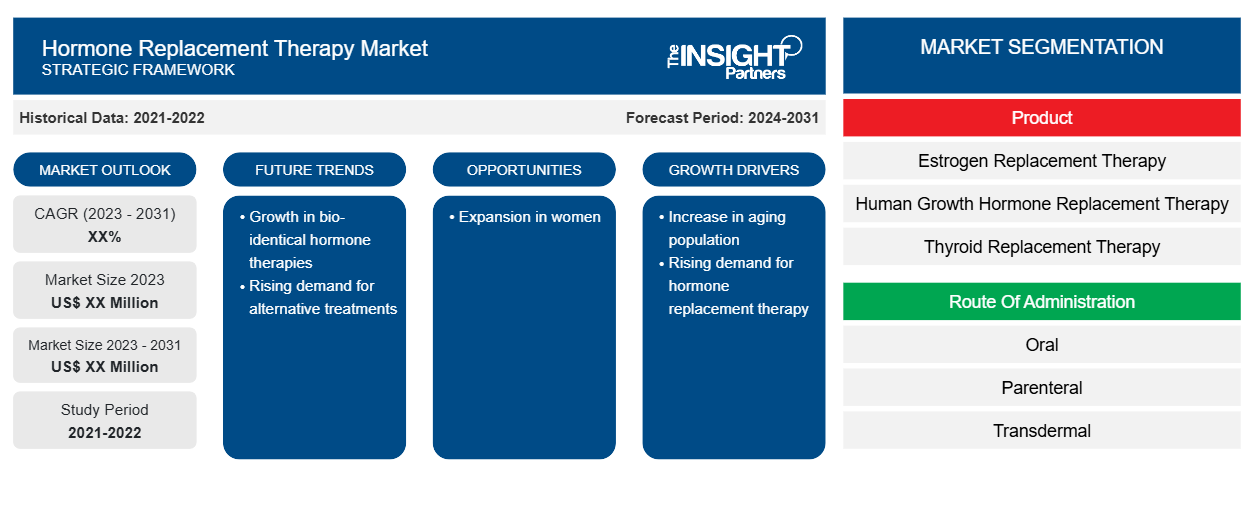ホルモン補充療法市場の予測は、この市場の関係者が成長戦略を概説するのに役立ちます。市場は2023年の84億6,000万米ドルから2031年までに148億2,000万米ドルに成長すると予測されており、2023年から2031年の間に7.3%のCAGRを記録すると推定されています。
ホルモン障害の増加、ホルモン欠乏症の認知度の高まり、HRT 製剤の改善などの要因により、ホルモン補充療法 (HRT) の世界的な需要は着実に増加しています。バイオアイデンティカル ホルモン補充療法 (BHRT) は、その明らかな安全性と有効性の利点により、合成ホルモンよりも人気が高まっています。BHRT は天然源から得られるため、体が自然に生成するホルモンによく似ていると考えられています。
製薬会社は、患者の利便性、コンプライアンス、安全性プロファイルを改善するために、経皮パッチ、ジェル、クリーム、皮下インプラントなどの新しいホルモン療法製剤の開発に投資しています。この要因は、ホルモン補充療法市場の成長を促進します。2023年8月、食品医薬品局(FDA)は、ANI Pharmaceuticalsの0.1%エストラジオールジェルの簡略化された新薬申請を承認しました。参考文献に記載されている薬剤Divigelは、更年期に伴う中程度から重度の血管運動症状の治療に使用されるエストロゲンホルモン療法です。Divigelのジェネリックは、エストラジオールジェル0.1%です。
成長の原動力:
幅広い用途がホルモン補充療法市場の成長を促進
ホルモン補充療法は、更年期障害や成長ホルモン欠乏症などの治療に処方されます。これらは、人の人生に重大な影響を及ぼす可能性があります。何百万人もの女性が、時には長期間にわたって HRT を使用しています。HRT は、さまざまな方法で骨粗鬆症を予防し、生活の質を向上させることができます。オレゴン健康科学大学によると、成長ホルモン欠乏症 (GHD) は一般的ではなく、米国では成人約 50,000 人、小児約 4,000 ~ 6,000 人に 1 人が罹患しています。したがって、この療法の使用の増加と、さまざまなホルモン障害の罹患率の増加が相まって、ホルモン補充療法治療市場の成長を牽引しています。
拘束:
医薬品の高コストがホルモン補充療法市場の成長を阻害
HRT 製品のコストは比較的高いです。たとえば、更年期センターによると、経口ホルモン補充療法の処方薬の価格は、1 か月あたり 130 ~ 240 米ドル (年間 1,560 ~ 2,440 米ドル) です。コストが高いため、これらの製品を定期的に使用することはできず、ホルモン補充療法市場の成長を抑制しています。
要件に合わせてレポートをカスタマイズする
このレポートの一部、国レベルの分析、Excelデータパックなど、あらゆるレポートを無料でカスタマイズできます。また、スタートアップや大学向けのお得なオファーや割引もご利用いただけます。
- このレポートの主要な市場動向を入手してください。この無料サンプルには、市場動向から見積もりや予測に至るまでのデータ分析が含まれます。
レポートのセグメンテーションと範囲:
ホルモン補充療法市場の分析は、療法、用途、投与経路、エンドユーザーというセグメントを考慮して実施されました。
治療法別に見ると、ホルモン補充療法市場は、エストロゲンホルモン補充、成長ホルモン補充、甲状腺ホルモン補充、テストステロン補充、その他に分類されます。エストロゲンホルモン補充セグメントは、2023年に最大の市場シェアを占めました。
ホルモン補充療法市場は、用途別に、更年期障害、成長ホルモン(GH)欠乏症、甲状腺機能低下症、性腺機能低下症などに分類されます。更年期障害セグメントは、2023年に最大のホルモン補充療法市場シェアを占め、予測期間中に最高のCAGRを記録すると予想されています。
地域分析:
地域別に見ると、ホルモン補充療法市場レポートの範囲には、北米、ヨーロッパ、アジア太平洋、中南米、中東およびアフリカが含まれます。2023年には、北米が最大の市場シェアを占めました。最新技術の採用の増加、ホルモン障害の有病率の上昇、新製品の早期採用、主要な市場プレーヤーの存在は、北米でのホルモン補充療法市場規模の急増に貢献しています。ファイザー社とOPKOヘルス社が発表した声明によると、2023年6月、週1回のヒト成長ホルモン類似体であるNGENLA(ソマトロゴングラ)が、内因性成長ホルモンの分泌不足によって引き起こされる成長不全の3歳以上の小児患者の治療に使用するために米国食品医薬品局(FDA)によって承認されました。
さらに、質の高い個別ケアへのアクセスの提供とヘルスケアソリューションの強化に重点が置かれることで、予測期間中にホルモン補充療法市場に大きなチャンスが生まれるでしょう。2023年5月、テキサス州最大のホルモン補充クリニックネットワークの1つであるHormones by Designが、統合機能医療プロバイダーの最初の全国ネットワークであるForum Health, LLCに買収されました。
ホルモン補充療法市場の地域別分析
予測期間を通じてホルモン補充療法市場に影響を与える地域的な傾向と要因は、Insight Partners のアナリストによって徹底的に説明されています。このセクションでは、北米、ヨーロッパ、アジア太平洋、中東およびアフリカ、南米および中米にわたるホルモン補充療法市場のセグメントと地理についても説明します。

- ホルモン補充療法市場の地域別データを入手
ホルモン補充療法市場レポートの範囲
| レポート属性 | 詳細 |
|---|---|
| 2023年の市場規模 | XX百万米ドル |
| 2031年までの市場規模 | XX百万米ドル |
| 世界のCAGR(2023年~2031年) | XX% |
| 履歴データ | 2021-2022 |
| 予測期間 | 2024-2031 |
| 対象セグメント | 製品別
|
| 対象地域と国 | 北米
|
| 市場リーダーと主要企業プロフィール |
|
ホルモン補充療法市場のプレーヤー密度:ビジネスダイナミクスへの影響を理解する
ホルモン補充療法市場は、消費者の嗜好の変化、技術の進歩、製品の利点に対する認識の高まりなどの要因により、エンドユーザーの需要が高まり、急速に成長しています。需要が高まるにつれて、企業は提供を拡大し、消費者のニーズを満たすために革新し、新たなトレンドを活用し、市場の成長をさらに促進しています。
市場プレーヤー密度とは、特定の市場または業界内で活動している企業または会社の分布を指します。これは、特定の市場スペースに、その市場規模または総市場価値に対してどれだけの競合相手 (市場プレーヤー) が存在するかを示します。
ホルモン補充療法市場で事業を展開している主要企業は次のとおりです。
- ファイザー株式会社
- アボット
- ノボ ノルディスク
- ノバルティスファーマ株式会社。
- メルク
免責事項:上記の企業は、特定の順序でランク付けされていません。

- ホルモン補充療法市場のトップキープレーヤーの概要を入手
業界の発展と将来の機会:
各社のプレスリリースによると、ホルモン補充療法市場で活動する大手企業による戦略的展開は以下のとおりです。
- 2024年1月、デンマークのAscendis Pharma A/SとVector Pharma FZCO(Vector)は、サウジアラビア、UAE、クウェート、オマーン、カタール、バーレーンの湾岸協力会議(GCC)諸国におけるYorvipathとSkytrofaの商業化に関する独占販売契約を締結しました。この独占販売契約の条件に従い、Vectorは自社の販売およびマーケティング経験を活用し、GCC諸国の患者に、Yorvipathの場合は成人の副甲状腺機能低下症、Skytrofaの場合は小児の成長ホルモン欠乏症(GHD)の治療薬としてYorvipathとSkytrofaを提供します。
競争環境と主要企業:
ホルモン補充療法市場レポートで紹介されている有名企業には、アストラゼネカ、ファイザー社、ノバルティス社、アボット社、トルマー社、パー・ファーマシューティカル社、メイン・ファーマ・グループ社、ノボ・ノルディスク社、イーライ・リリー・アンド・カンパニー社、ノーベン・ファーマシューティカル社などがあります。これらの企業は、世界中で高まる消費者の需要を満たすために、新技術の開発、既存製品のアップグレード、地理的プレゼンスの拡大に注力しています。
- 過去2年間の分析、基準年、CAGRによる予測(7年間)
- PEST分析とSWOT分析
- 市場規模価値/数量 - 世界、地域、国
- 業界と競争環境
- Excel データセット


- Europe Industrial Chillers Market
- Human Microbiome Market
- Skin Tightening Market
- Single-Use Negative Pressure Wound Therapy Devices Market
- Energy Recovery Ventilator Market
- Small Satellite Market
- Wire Harness Market
- Redistribution Layer Material Market
- Railway Braking System Market
- Long Read Sequencing Market

Report Coverage
Revenue forecast, Company Analysis, Industry landscape, Growth factors, and Trends

Segment Covered
This text is related
to segments covered.

Regional Scope
North America, Europe, Asia Pacific, Middle East & Africa, South & Central America

Country Scope
This text is related
to country scope.
よくある質問
By therapy, the market is segmented into estrogen hormone replacement, growth hormone replacement, thyroid hormone replacement, testosterone replacement, and others. The estrogen hormone replacement segment held a larger hormone replacement therapy market share in 2023.
Increasing use of hormone replacement therapy products and increasing prevalence of hormone disorder propel the hormone replacement therapy market growth. However, high cost of medications hampers the growth of the market.
The hormone replacement therapy market majorly consists of the players, including Astrazeneca, Pfizer Inc., Novartis AG, Abbott, Tolmar Inc, Par Pharmaceutical, Mayne Pharma Group Limited, Novo Nordisk A/S, Eli Lily And Company, and Noven Pharmaceuticals, Inc.
Medication that contains female hormones is known as hormone replacement treatment. When you go through menopause, your body stops producing estrogen, so you take medication to replace it. The most common menopausal symptoms that hormone therapy is used to treat are hot flashes and vaginal discomfort.
The market, by distribution channel, is categorized into menopause, growth hormone (GH) deficiency, hypothyroidism, hypogonadism, and others. The menopause segment held the largest menopause market share in 2023, and it is anticipated to register the highest CAGR during the forecast period.
The hormone replacement therapy market is expected to be valued at US$ 14.82 billion in 2031.
The hormone replacement therapy market was valued at US$ 8.46 billion in 2023.
Trends and growth analysis reports related to Life Sciences : READ MORE..
The List of Companies - Hormone Replacement Therapy Market
- Astrazeneca
- Pfizer Inc.
- Novartis AG
- Abbott
- Tolmar Inc
- Par Pharmaceutical
- Mayne Pharma Group Limited
- Novo Nordisk A/S
- Eli Lily And Company
- Noven Pharmaceuticals, Inc.
The Insight Partners performs research in 4 major stages: Data Collection & Secondary Research, Primary Research, Data Analysis and Data Triangulation & Final Review.
- Data Collection and Secondary Research:
As a market research and consulting firm operating from a decade, we have published and advised several client across the globe. First step for any study will start with an assessment of currently available data and insights from existing reports. Further, historical and current market information is collected from Investor Presentations, Annual Reports, SEC Filings, etc., and other information related to company’s performance and market positioning are gathered from Paid Databases (Factiva, Hoovers, and Reuters) and various other publications available in public domain.
Several associations trade associates, technical forums, institutes, societies and organization are accessed to gain technical as well as market related insights through their publications such as research papers, blogs and press releases related to the studies are referred to get cues about the market. Further, white papers, journals, magazines, and other news articles published in last 3 years are scrutinized and analyzed to understand the current market trends.
- Primary Research:
The primarily interview analysis comprise of data obtained from industry participants interview and answers to survey questions gathered by in-house primary team.
For primary research, interviews are conducted with industry experts/CEOs/Marketing Managers/VPs/Subject Matter Experts from both demand and supply side to get a 360-degree view of the market. The primary team conducts several interviews based on the complexity of the markets to understand the various market trends and dynamics which makes research more credible and precise.
A typical research interview fulfils the following functions:
- Provides first-hand information on the market size, market trends, growth trends, competitive landscape, and outlook
- Validates and strengthens in-house secondary research findings
- Develops the analysis team’s expertise and market understanding
Primary research involves email interactions and telephone interviews for each market, category, segment, and sub-segment across geographies. The participants who typically take part in such a process include, but are not limited to:
- Industry participants: VPs, business development managers, market intelligence managers and national sales managers
- Outside experts: Valuation experts, research analysts and key opinion leaders specializing in the electronics and semiconductor industry.
Below is the breakup of our primary respondents by company, designation, and region:

Once we receive the confirmation from primary research sources or primary respondents, we finalize the base year market estimation and forecast the data as per the macroeconomic and microeconomic factors assessed during data collection.
- Data Analysis:
Once data is validated through both secondary as well as primary respondents, we finalize the market estimations by hypothesis formulation and factor analysis at regional and country level.
- Macro-Economic Factor Analysis:
We analyse macroeconomic indicators such the gross domestic product (GDP), increase in the demand for goods and services across industries, technological advancement, regional economic growth, governmental policies, the influence of COVID-19, PEST analysis, and other aspects. This analysis aids in setting benchmarks for various nations/regions and approximating market splits. Additionally, the general trend of the aforementioned components aid in determining the market's development possibilities.
- Country Level Data:
Various factors that are especially aligned to the country are taken into account to determine the market size for a certain area and country, including the presence of vendors, such as headquarters and offices, the country's GDP, demand patterns, and industry growth. To comprehend the market dynamics for the nation, a number of growth variables, inhibitors, application areas, and current market trends are researched. The aforementioned elements aid in determining the country's overall market's growth potential.
- Company Profile:
The “Table of Contents” is formulated by listing and analyzing more than 25 - 30 companies operating in the market ecosystem across geographies. However, we profile only 10 companies as a standard practice in our syndicate reports. These 10 companies comprise leading, emerging, and regional players. Nonetheless, our analysis is not restricted to the 10 listed companies, we also analyze other companies present in the market to develop a holistic view and understand the prevailing trends. The “Company Profiles” section in the report covers key facts, business description, products & services, financial information, SWOT analysis, and key developments. The financial information presented is extracted from the annual reports and official documents of the publicly listed companies. Upon collecting the information for the sections of respective companies, we verify them via various primary sources and then compile the data in respective company profiles. The company level information helps us in deriving the base number as well as in forecasting the market size.
- Developing Base Number:
Aggregation of sales statistics (2020-2022) and macro-economic factor, and other secondary and primary research insights are utilized to arrive at base number and related market shares for 2022. The data gaps are identified in this step and relevant market data is analyzed, collected from paid primary interviews or databases. On finalizing the base year market size, forecasts are developed on the basis of macro-economic, industry and market growth factors and company level analysis.
- Data Triangulation and Final Review:
The market findings and base year market size calculations are validated from supply as well as demand side. Demand side validations are based on macro-economic factor analysis and benchmarks for respective regions and countries. In case of supply side validations, revenues of major companies are estimated (in case not available) based on industry benchmark, approximate number of employees, product portfolio, and primary interviews revenues are gathered. Further revenue from target product/service segment is assessed to avoid overshooting of market statistics. In case of heavy deviations between supply and demand side values, all thes steps are repeated to achieve synchronization.
We follow an iterative model, wherein we share our research findings with Subject Matter Experts (SME’s) and Key Opinion Leaders (KOLs) until consensus view of the market is not formulated – this model negates any drastic deviation in the opinions of experts. Only validated and universally acceptable research findings are quoted in our reports.
We have important check points that we use to validate our research findings – which we call – data triangulation, where we validate the information, we generate from secondary sources with primary interviews and then we re-validate with our internal data bases and Subject matter experts. This comprehensive model enables us to deliver high quality, reliable data in shortest possible time.


 このレポートの無料サンプルを入手する
このレポートの無料サンプルを入手する